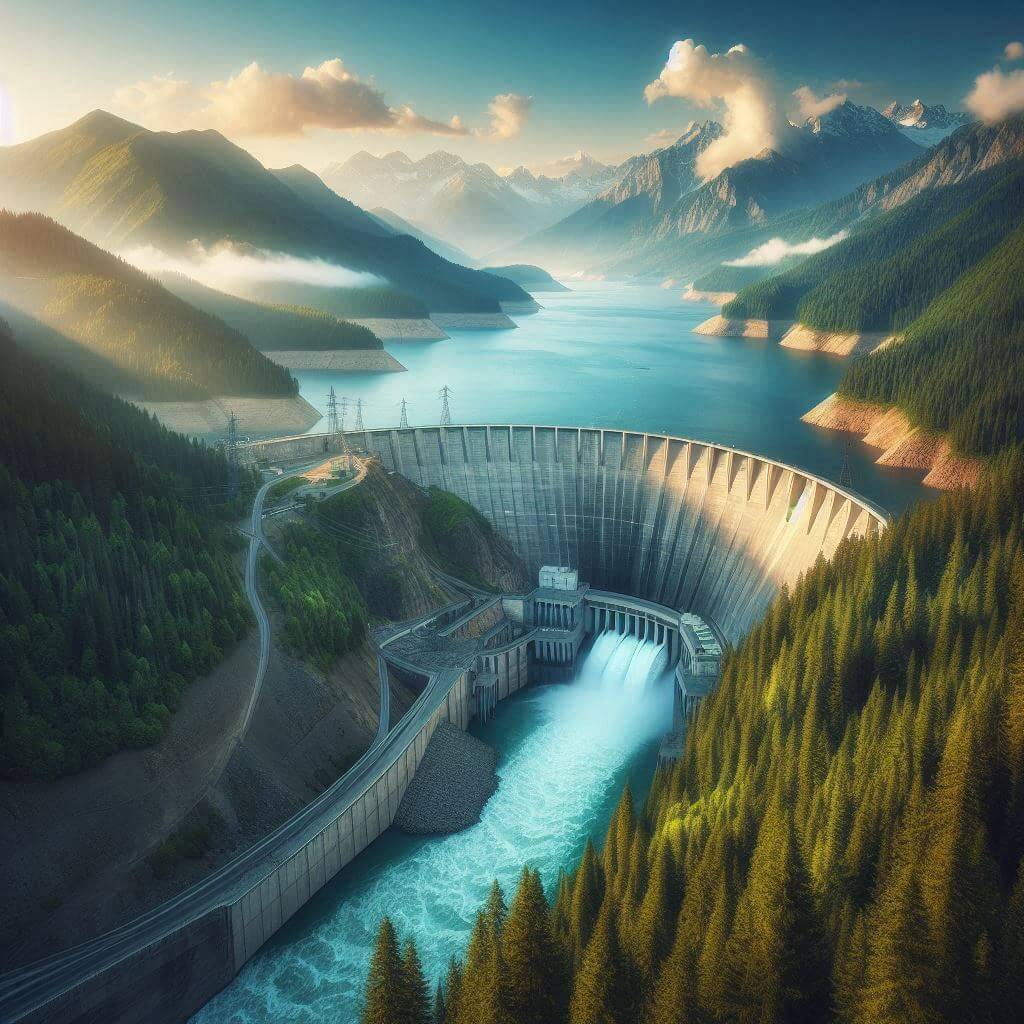Pumped storage hydropower (PSH) is an innovative solution to meet the growing demand for renewable energy in today’s world. Although it is not a new technology, having been in use for over a century, the current global focus on sustainable energy has sparked renewed interest in the approach. At its core, pumped storage hydropower is a type of hydroelectric power generation that is used to store energy for later use. It functions like a large battery, helping to balance the supply and demand of electricity. As countries strive to reduce their dependence on fossil fuels and increase their use of renewable energy sources such as wind and solar, PSH offers a reliable and efficient way to cope with the variability of these resources.
How A Pumped Storage Hydroelectric Plant Works
A pumped storage hydroelectric plant works on a simple principle involving two reservoir systems at different elevations. The main components include an upper reservoir located at a higher elevation and a lower reservoir located at a lower elevation. The fundamental process begins when there is more electricity on the grid than is currently needed, which often occurs during periods of low electricity demand. At this time, the excess electricity is used to activate pumps that transport fluid from the lower reservoir to the upper one. This process stores energy by increasing the potential energy of the transferred fluid.
When electricity demand peaks, typically in the morning and evening when residential and commercial use increases, the stored fluid is released from the upper reservoir. As it flows back down into the lower reservoir, it flows through turbines connected to generators. The force of the moving fluid turns turbines, converting the stored potential energy into mechanical energy, which is then converted into electrical energy by generators. This electricity is then fed back into the grid to meet increased demand.
 One of the key advantages of this system is its ability to respond quickly. Pumped storage plants can start generating electricity quickly, often within minutes, to provide immediate support to the grid. Such rapid response is crucial for stabilizing the grid, especially when demand fluctuates or when there is a sudden drop in supply from other sources such as wind or solar.
One of the key advantages of this system is its ability to respond quickly. Pumped storage plants can start generating electricity quickly, often within minutes, to provide immediate support to the grid. Such rapid response is crucial for stabilizing the grid, especially when demand fluctuates or when there is a sudden drop in supply from other sources such as wind or solar.
Another aspect to consider is the efficiency of the system. Modern pumped storage plants achieve efficiencies of around 70% to 80%, meaning that a significant portion of the energy used to pump the fluid into the upper reservoir is returned as it flows back through the turbines. This makes pumped storage one of the most efficient forms of large-scale energy storage.
Hydroelectric storage systems are also highly adaptable to the needs of the grid. Operators can adjust the timing and rate of storage and generation to best match supply and demand conditions. This adaptability is particularly useful in grids with a high share of renewable energy sources, which are inherently variable. By storing excess energy produced during periods of strong wind or strong sunlight, a hydroelectric storage system can help integrate renewables more effectively into the power system and ensure a stable electricity supply.
Historical Significance And Modern Development
Hydropumped hydroelectricity has a long history, dating back to the early 20th century. The first known commercial facility was built in Switzerland in 1909 at the Engeweiher pumped storage station. Such early adoption in Europe was primarily driven by the need to balance the supply and demand for electricity. At the time, thermal power plants, the main source of electricity, needed a way to maintain stable operation even when demand was not at its peak. Pumped storage provided an efficient means of using excess generation at night, storing it for use during daytime peaks.
In the United States, the first pumped storage facility appeared in 1930 at the Rocky River Plant in Connecticut. The post-war economic boom and the increasing electrification of residential and industrial sectors further accelerated the development until the mid-20th century. At that time, electrical grids were expanding rapidly and needed reliable systems to ensure reliability and stability.
These early systems laid the foundation for much larger installations. The 1970s saw the emergence of major projects such as the Bath County Pumped Storage System in Virginia, USA, which remains the largest in the world. These facilities demonstrated the technology’s ability to provide significant energy storage capacity, contributing to both grid stability and the cost-effective operation of power systems.
In the modern era, the focus has shifted towards integrating pumped storage into the renewable energy mix. Countries are increasingly seeking to reduce carbon emissions and mitigate climate change by increasing the share of renewable energy in their grids. This shift has renewed interest in pumped storage because of its ability to store renewable energy that is not needed at the time of generation and then release it when demand increases.
Technological and engineering advances have improved both the efficiency and environmental friendliness of new projects. For example, closed-loop systems are being developed and implemented to minimize environmental impact because they do not rely on natural bodies of fluid, but instead use constructed basins. These systems help reduce potential environmental disruption, making modern projects more sustainable and acceptable to communities and environmental groups.
Another recent development has been the increased use of reversible pumped-storage systems, which allow facilities to switch between pumping and generating modes more efficiently. This improvement reduces transition times, allowing for faster response to grid demands.
At the same time, more attention is being paid to improving the economics of the pumped-storage system. The introduction of market mechanisms that provide compensation for ancillary services such as frequency regulation and grid stability offers financial incentives for flexible facility operation.
Challenges and Opportunities
Storage-storage hydropower systems face several challenges that need to be addressed to maximize their potential benefits. One significant challenge is the geographical constraints on construction. Ideal locations require specific topographical conditions, such as a sufficiently large elevation difference between upper and lower reservoirs, to maximize energy storage potential. Such sites are often located in remote or environmentally sensitive areas, which can make development difficult due to logistical and regulatory hurdles.
Another major challenge is the high initial cost. Building pumped-storage facilities involves significant investments, with costs running into billions of dollars for large facilities. The long construction time, which can last from several years to decades, can also deter investors seeking a faster return on investment. These significant upfront costs can be a barrier, especially in regions with limited financial resources or where there is no support for energy policy.
Environmental considerations further complicate site selection and project approval. Traditional open-loop systems that rely on natural bodies can impact local ecosystems and biodiversity. Regulatory frameworks in many countries require detailed environmental assessments and mitigation strategies, which can extend project timelines and increase costs. Concerns from local communities and environmental organizations often lead to public opposition that can delay or halt projects.
Despite these challenges, there are significant opportunities in the pumped storage arena, especially as the world transitions to sustainable energy systems. A key opportunity lies in its ability to support grid integration of renewable energy sources such as wind and solar, which are inherently variable. By providing reliable storage, pumped storage systems can effectively address the problem of outages, ensuring a stable supply of electricity despite fluctuations in generation.
Pumped storage systems offer ancillary services that are increasingly valued in today’s electricity markets. They can stabilize frequency and voltage, provide rotating reserves, and contribute to grid reliability, functions that intermittent generation sources cannot consistently perform. With the creation of markets for these services, there is now a financial incentive that can make pumped storage gas projects more economically viable.
Technological advances are also creating opportunities to overcome some of the current challenges. Innovations in reversible pump-turbine technologies and the development of closed-loop systems are minimizing environmental impacts and increasing operational efficiency. In addition, new software solutions for grid management allow for better forecasting and rapid response, further optimizing the use of stored energy.

